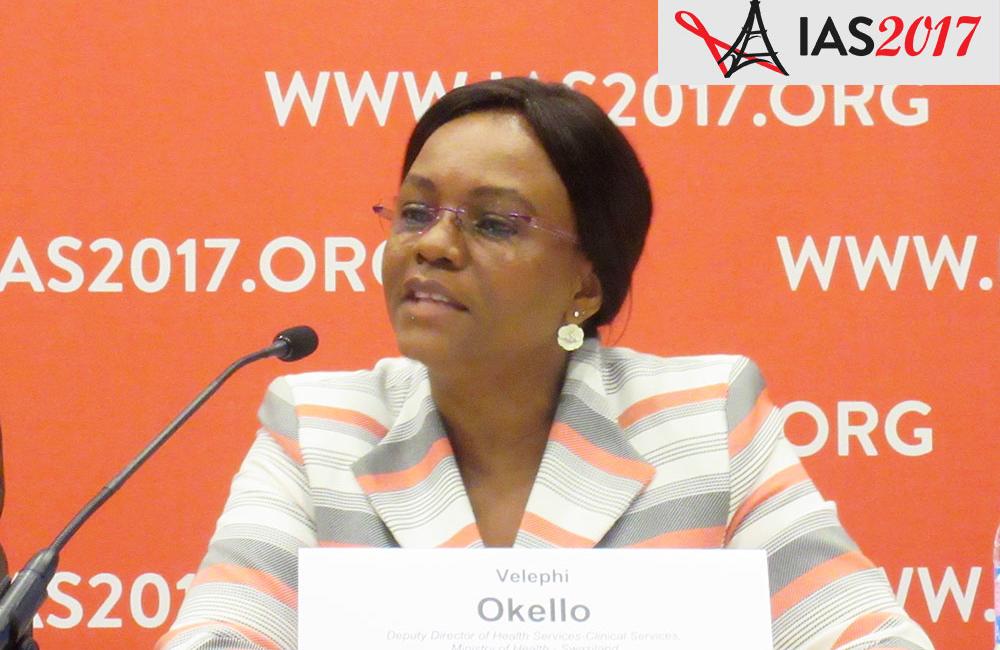
New HIV infections have halved in Swaziland since 2011 at the same time as the proportion of people on antiretroviral treatment with fully suppressed viral load has doubled, the 9th International AIDS Society Conference on HIV Science (IAS 2017) heard in Paris, France, today. It is the first direct evidence that expanding HIV treatment results in fewer HIV infections in a country with a major epidemic, researchers said.
The study “shows that our efforts can pay off and is a proof of concept”, said Professor Linda Gail-Bekker, President of the International AIDS Society.
Conference Co-Chair Jean-Francois Delfraissy described the results as “fantastic” and the audience at this morning’s presentation greeted the findings with prolonged applause.
Although the effect of HIV treatment on stopping HIV transmission is well established at the individual or couple level, the impact of wider uptake of treatment on HIV transmission at the population level is less well understood. Research in Kwazulu-Natal province, South Africa, has shown that an increase in HIV treatment coverage is associated with a fall in HIV incidence. What has been lacking, until now, is evidence that increasing the proportion of people living with HIV who have fully suppressed viral load is associated with a decline in new HIV infections.
The Kingdom of Swaziland has one of the most severe HIV epidemics in the world. In a country with a population of 1.45 million, just under a third (32%) were estimated to be living with HIV in 2011, when the country conducted its first door-to-door HIV testing exercise.
Since 2011, Swaziland has scaled up access to antiretroviral treatment and testing, adopting the 'treat all' approach recommended by the World Health Organization and enabling nurses to start people on antiretroviral treatment to speed up treatment initiation. The number of HIV tests carried out each year has almost tripled since 2011 and the number of men who have undergone medical circumcision has more than doubled. The number of people on antiretroviral treatment grew from 72,402 in 2011 to 171,266 in 2016.
The 2011 survey tested 18,172 people aged 15 years and over, sampled through home-based testing. The survey found an HIV prevalence of 24.1% in men and 38.8% in women, and found that 1.8% of men and 3.16% of women had acquired HIV within the previous 120 days. At this time, 34.8% of people living with HIV had a suppressed viral load.
A second survey was carried out in 2016-17 to look at whether HIV incidence had risen, stayed the same or declined and to find out what proportion of people with HIV had a suppressed viral load. Clinic records may not show all people living with HIV because a proportion might be lost to follow-up, or because viral load testing is not available, so a door-to-door sampling of viral load gives a more accurate picture of how many people living with HIV are on fully effective treatment and cannot pass on HIV to sexual partners.
The 2016 survey selected 286 districts at random and 6417 households within those districts for offers of testing. Household members aged 15 and over who consented to testing received an HIV antibody test and a point-of-care CD4 test.
All samples testing positive for HIV antibodies were tested for HIV RNA and HIV antigen at a central laboratory, to identify recent infections. Both surveys used an assay which is designed to recognise HIV antigen produced in the first four months (130 days) after infection, a limiting antigen avidity assay.
A total of 10,934 people over the age of 15 were tested. Eighty-four per cent of households took part, and 92% of men and 95% of women agreed to be tested. The survey found no significant change in HIV prevalence in women or men (38.1 and 21.2% respectively), but a significant reduction in new HIV infections. In men, HIV incidence fell by 53%, from 1.83 to 0.86%. In women, HIV incidence fell by 38%, from 3.16 to 1.95%. Overall, HIV incidence fell by 44% (p = 0.012).
Viral load suppression doubled between 2011 and 2016-17, from 34.8 to 71.3%.
The survey found that more women knew their HIV status than men (88.6 vs 77.5%), but there was no substantive difference in the proportions of men and women on treatment (87.4% overall) and virally suppressed (91.9% overall).
People over 25 years of age were more likely to know their HIV status, to be on treatment and to be virally suppressed, consistent with findings from many other African countries. Presenting the results, Velephi Okello of the Kingdom of Swaziland Ministry of Health said that further efforts to engage men and young people were needed to achieve the 90-90-90 target.
Nkambule R et al. Substantial progress in confronting the HIV epidemic in Swaziland: first evidence of national impact. 9th International AIDS Society Conference on HIV Science, Paris, abstract MOAX0204LB, July 2017.
View the abstract on the conference website.
Download the presentation slides from the conference website.
